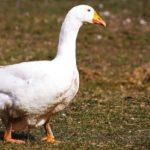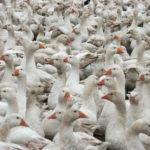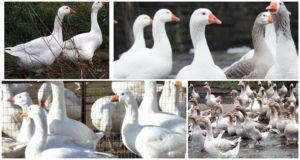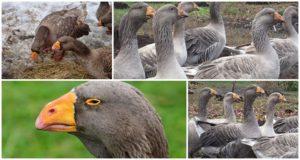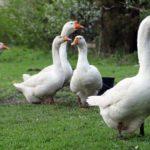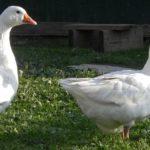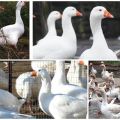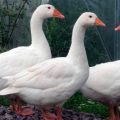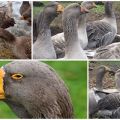Description and characteristics of geese of the Bashkir breed, rules for their breeding
Breeding geese is a simple and profitable business. Birds grow quickly, providing their owners with delicious nutritious meat, large eggs, and liver. Down and feathers are used to make clothes and bedding. For breeding, it is better to acquire high-quality young animals that can give strong productive offspring. Bashkir geese are popular with farmers. A more detailed story about the distinctive qualities of these birds.
Breeding history
The ancestor of the Bashkir geese is the common gray goose. When developing this breed, the task was to obtain birds that easily adapt to a cold climate and a limited amount of water. In this case, the geese had to quickly gain weight.
The breeders coped with all the tasks: the Bashkir goose is slightly lighter than the heavy varieties of these birds, but gains 3 kilograms 2 months after birth. Therefore, it is suitable for industrial cultivation, personal rural households. Even summer residents who go out of town only for the summer choose this breed in order to get high-quality fresh meat for the family table.
Description and characteristics of Bashkir geese
The Bashkir goose belongs to the easy sale of geese, if the gray gander reaches a mass of 8-9 kilograms, then the mass of the Bashkir goose is 3-5 kilograms. Moreover, the mass is recruited very quickly with minimal food costs; a couple of months after birth, the bird is suitable for slaughter, since it gains 3 kilograms. These geese are sometimes called Bashkir linda for their external similarity, but the true linda is larger in size.
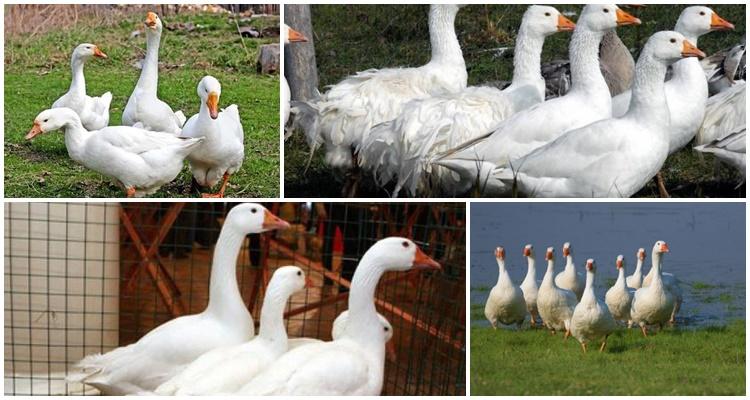
Bashkir geese are distinguished by high egg production, eggs of this breed are not inferior to chicken eggs, they can be used not only in baking.
Geese of this breed are responsible mothers, they very rarely leave their nests. The survival rate of chicks is 95-98%, which is a high indicator. The birds are not afraid of frost, they adapt to difficult conditions of detention. These are beautiful compact individuals with white plumage and one fat fold on the belly, with bright orange paws and an orange-colored beak with a white border at the base. They have strong immunity and high resistance to disease.
Advantages and disadvantages
Birds can withstand harsh winters, they do not need a reservoir, a small container is enough for them to splash. Since the chicks are growing rapidly, the carcasses are not too fat. When slaughtered at 2 months, they are neat, since molting in goslings begins 70-75 days after hatching from eggs. The choice of this type of geese ensures a high profitability for the poultry business.
Conditions of maintenance and care
Birds are not afraid of frost, but they suffer from high humidity in the room. The house for them must be dry, well ventilated and free of drafts. Windows are required in it, in winter additional lighting should be turned on in order to increase daylight hours to 14 hours.
Geese are sensitive to odors. The litter must be changed systematically. For her, use shavings or straw. The floor in the room is made earthen, concrete, wooden. With the concrete option, the floors are colder, the thickness of the litter should be increased. Wood is a less practical option.
The house must be at least 2 meters high, with a roof that is resistant to rain and snow. Feeders and drinkers for birds are placed in it, a practical solution is the remains of plastic plumbing pipes. These feeders are easy to clean, have high sides and have no sharp corners. In addition to feeders and drinkers, geese need containers with an ash-sand mixture, they leave chalk and crushed shells for them in the poultry house.
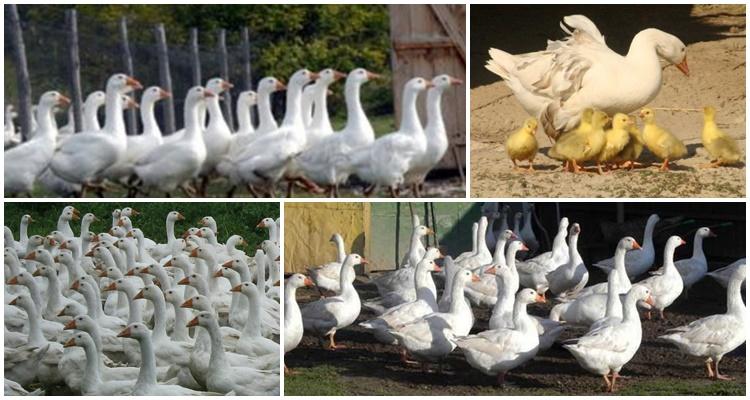
For each head in the poultry house, for geese of the Bashkir breed, there should be 0.7-0.8 square meters of area. The house should be fenced off with a net to separate adult birds from young birds and geese in nests.
Houses are built for the nests, they can be separate for each goose or common, for 3-4 nests. A large house requires dense, opaque partitions.
In addition to the poultry house, the geese are fenced off nearby, since it is a mobile, energetic bird. Birds should be driven out daily in dry weather. They walk even in winter at temperatures down to minus 15 ° C, for 1-2 hours. In summer, the birds are equipped with a larger walking area, with a canopy under which the birds hide from the bright sun, rain and wind. They can be on it around the clock in good weather. If there is enough grass for the walk, the birds feed on their own, if not, the owners bring the grass to them.
Diet
Geese are unpretentious in food. Since they grow quickly, they eat a lot of food per day.
In winter
They stop grazing geese after the onset of the first frost. They are fed in winter 3 times a day. In the morning, they give crushed grain, adding feed yeast there. Each head per day needs 300 grams of grain mixture, 1 kilogram of vegetables (potatoes, beets, carrots, pumpkin). Chop the vegetables. In addition, hay is placed in the feeders.
In the evening, the birds receive silage, crushed oats, corn, wheat. 2-3 times a week, the birds are gradually given meat and bone waste. Protein is a must in the diet of poultry. Waste from fish production can be given.
Summer
In good weather, the birds are walking around the clock. They eat up to 2 kilograms of grass daily. In the evening, they are given 100-120 grams of grain mixture. The diet should contain feed yeast, bone meal and fish meal. Birds need access to clean water, small stones for good digestion, place containers with chalk and small shells.

Reproduction
There should be 3-4 geese for each gander. They hatch chicks from February to April. Eggs can be placed under the goose or placed in an incubator. If they are heavily soiled immediately, while still warm, they are washed with a warm, slightly pink solution of potassium permanganate. If the infection enters the egg through the open pores, the chicks will not hatch.
The goose sits on eggs for 28-30 days. During this time, she should not be disturbed. There should always be food and water near the nest.After the goslings appear, they are taken from their mother and placed under a lamp. In the first days, the goslings are given a chopped boiled egg; after a week, cottage cheese should be added to the eggs. Then - finely chopped green nettles. If it's warm outside, 10-12-day-old goslings are sent to pasture.
Where to buy and cost
Pedigree specimens are purchased in breeding farms, at agricultural exhibitions, from trusted producers in their region. You can buy adult geese for the tribe or small goslings. SPC "OOO Bashkirskiy" goose has its representative offices in different cities of Russia. The cost of per diem goslings is about 150 rubles, grown up - up to 400 rubles.
Raising geese allows you to observe the life of birds. For many, a hobby eventually develops into a serious business. Rapid growth, the taste of meat, the opportunity to enjoy gourmet cookies, the high cost of products add to the popularity of the occupation.

